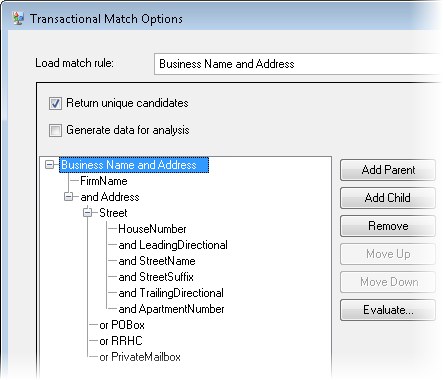Match Rules
Each of the matching stages (Interflow Match, Intraflow Match, and Transactional Match) require you to configure a match rule. A match rule defines the criteria that are used to determine if one record matches another. It specifies the fields to compare, how to compare the fields, and a hierarchy of comparisons for complex matching rules.
Creating a hierarchical set of comparisons allows you to form nested Boolean match rules. For example, consider the following match rule:

In this example, the match rule is attempting to match records based on a business name and address. The first element of the match rule is the FirmName field. This element means that the value in the FirmName field must match in order for records to match. The second element evaluates the address. Note that it is prefaced with the logical operator "and" which means that both the FirmName and Address must match in order for records to match. The Address portion of the match rule consists of child rules that evaluate four types of addresses: street addresses, PO Box addresses, Rural Route/Highway Contract (RRHC) addresses, and private mailbox addresses. The Street child looks at the dataflow fields HouseNumber, LeadingDirectional, StreetName, StreetSuffix, TrailingDirectional, and ApartmentNumber. If all these match, then the parent rule "Street" and its parent rule "Address" all evaluate to "true". If the Street rule does not evaluate to true, the POBox field is evaluated, then RRHC, then PrivateMailbox. If any of these three match then the parent Address element will match.